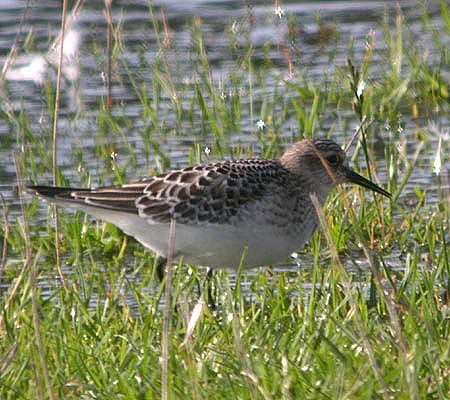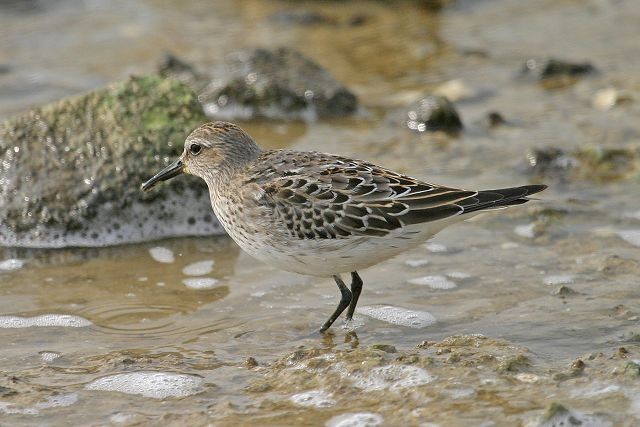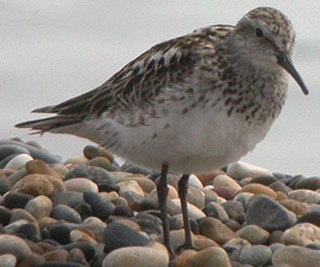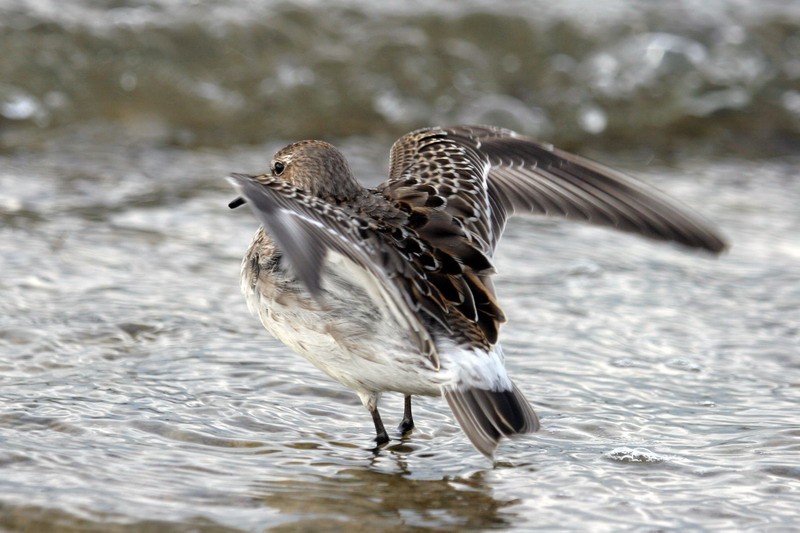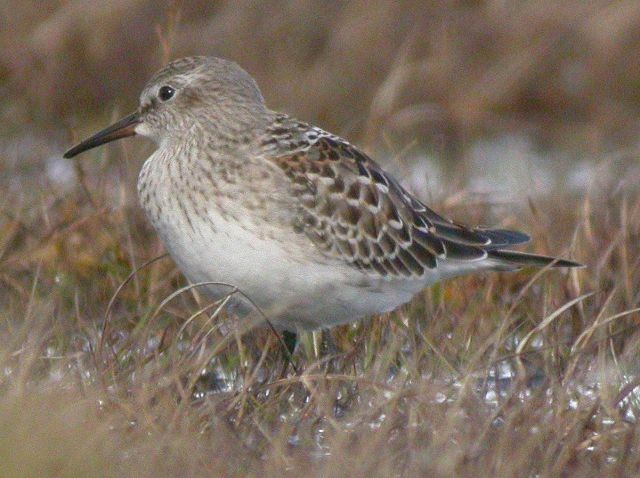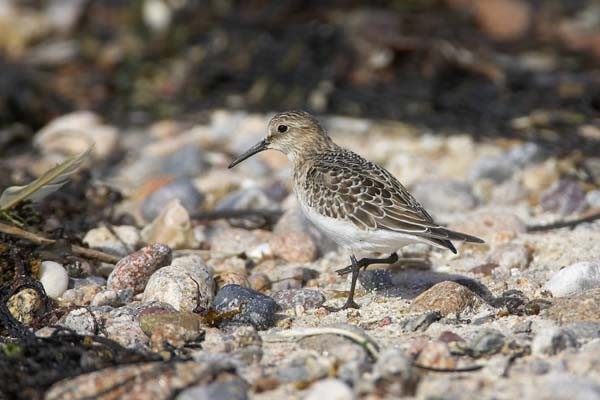
Baird's Sandpiper: Juvenile, Scilly, September. A classic juvenile, in a classic southwestern setting. A rather nondescript species in many respects, the 'scalloped' upperparts makes it stand out from its congeners. Note the attenuated body and long primaries - three visible primaries extend beyond the tail making an obvious scissor-shape. The primary extension equates to the tertial length (photo: Chris Brogdale).
Introduction
Autumn is an exciting time for wader-watchers. Carefully sifting through flocks of commoner species, a number of scarce options are on offer for would-be 'self-finders', especially after an Atlantic depression has passed through. One of the more frequently encountered of the rare 'peeps' in Britain and Ireland is the Baird's Sandpiper. With 185 British records by the end of 2004 and in the region of 90 Irish records, this subtle stint is surprisingly regular on this side of the Atlantic considering its relative scarcity along the eastern states of North America.
Baird's Sandpiper was one of the last sandpipers to be described in North America. The breeding range is restricted to the high Arctic of North America, northwest Greenland and northeast Siberia. Its journey to wintering grounds in South America, from the Andes of Ecuador to the lowlands of Tierra del Fuego, is one of the longest of all bird species and one that is undertaken rapidly. Some birds undertake the journey to the southern tip of South America in as little as five weeks.
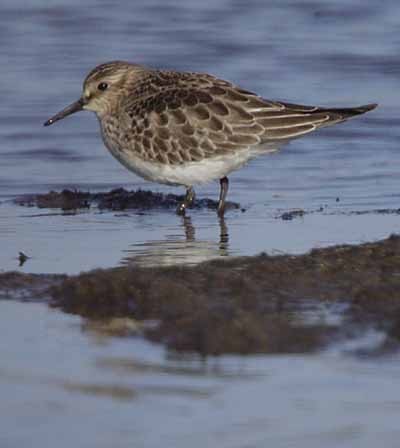
Baird's Sandpiper: Juvenile, Hampshire, September. Note the broad flat back. The bill is all black, and the head bland, with a diffuse supercilium and pale supraloral spot (photo: Tony Mills).
In the autumn adults leave the breeding grounds for staging areas in the prairies from late July to August, migrating through central North America. From their staging areas they then take a route over the eastern Pacific to the wintering grounds, bypassing Central America. The migration of juveniles is a less urgent affair, taking place on a broader front, with small numbers following the Atlantic coast. It seems that many of the birds reaching us in Northwest Europe originate from birds displaced from this migration route by rapid Atlantic depressions.
Sightings here are annual, with numbers plentiful in some years, and low double-figure annual totals achieved several times since the late 1980s. Favoured areas include southwest Britain and southern Ireland, though relatively few counties are yet to record the species at least once. The overwhelming majority of birds have been September juveniles, and records outside the late-August-to-early-October period are quite rare. Spring and summer records are unusual, and a wintering 1st-winter at Staines Reservoirs (Surrey) from 14th October 1982 to 24th April 1983 was quite exceptional.
Identification
Your typical Baird's lies between Little Stint and Dunlin in size. The long wings, essential for their mammoth migration, give them an attenuated appearance, shared only with White-rumped Sandpiper. On the face of it, this 'species pair' should not present much of an identification conundrum. With good views, or images, these two should be easily separated, especially if the 'rump' of the latter is revealed. However, separation of the two can sometimes be problematical, especially with distant views. If you are lucky enough to find yourself in the position of having to separate one, or the other, of these two species then do not become complacent under less-than-ideal viewing conditions.
The long-bodied and flat-backed profile of Baird's can be exaggerated further by its apparent 'short-legged' appearance, though at times this can be deceiving as Baird's can also appear quite 'leggy'. In all plumages the bill has a thinner base, and is straighter than White-rumped. The bill is also all-dark, lacking the pale base of White-rumped. The call differs too, being a rolled, or trilled, pair-r-r-reet or krreep.
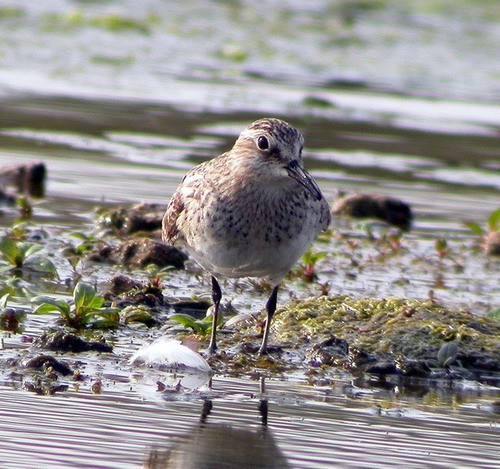
Baird's Sandpiper: Adult, Lincolnshire, September. The streaked breast band recalls a small Pectoral Sandpiper, but is not clearly demarcated as in that species (photo: Dean Eades).
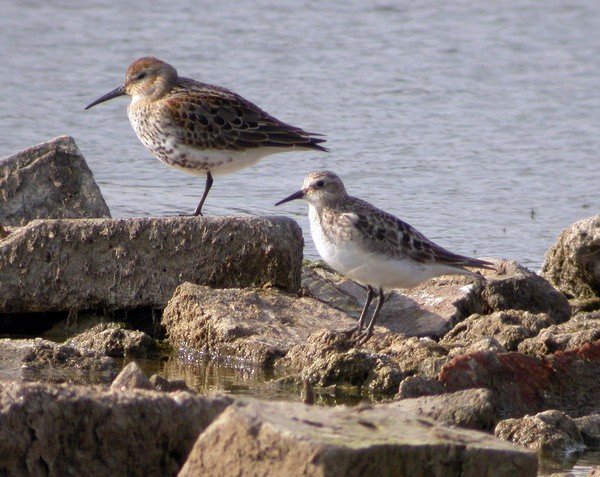 | ||||||||
| Baird's Sandpiper: Adult, Lincolnshire, September. This portrait illustrates the different 'jizz' compared with the benchmark Calidrid, Dunlin (behind). Note also the dark feather centres to the upperparts, a feature of adults (photo: Russell Hayes).
Baird's in summer plumage are very much in the minority in Britain and Ireland, but a number of differences allow straightforward separation from White-rumped in such plumage. Summer birds are buffy in colour, with the upperparts showing dark centres to some scapular and mantle feathers. The breast is a buffy wash with variable streaking. Adult winter is a plumage unlikely to be encountered by birders on this side of the Atlantic, but such birds have plainer upperparts and paler feather fringes.
Many birders who have seen Baird's will have encountered an intricately marked juvenile. The scalloped patterning of young birds is reminiscent of juvenile Curlew Sandpiper in many ways, albeit a smaller version. Juveniles are decidedly buffy on the head and breast, lacking any obvious features, except for a pale chin and pale supraloral spot and an indistinct broad supercilium. Close up, a narrow white eye-ring is obvious. The breast-band is diffusely streaked, but lacks the clear-cut definition of a Pectoral Sandpiper.
Baird's tend to favour freshwater and drier habitat, in comparison to the saline preference of White-rumped. They can be found anywhere from the short turf of an airfield to a flooded coastal pool. Where a bird is present with carrier species it can often be found away from the flock frequenting the muddy margins, furtively exploring a dry area some distance away! Of course there are plenty of exceptions to the rule, so habitat and actions cannot be used solely for identification purposes but can provide a useful starting point.
The White-rumped Sandpiper 'problem'The most obvious pitfall lies with White-rumped Sandpiper, which shares the long-bodied, long-winged and short-legged appearance. For both species the wing tips project beyond the tail. However, given good views White-rumped should be readily eliminated in all plumages and, of course, once seen, the white uppertail coverts make the identification problem redundant!
However, if the bird in front of you is not so obliging, there are various clues to the identity to look for in all plumages. The bill of White-rumped tends to be thicker-based and much more decurved than Baird's, plus White-rumped always shows a pale base to the lower mandible. On White-rumped the narrow supercilium appears as distinct, and whitish, behind the eye as it is in front of the eye. On Baird's the broad supercilium behind the eye tends to be less striking. Calls of the two species differ too, White-rumped uttering an indistinct jeet or tzeet.
|
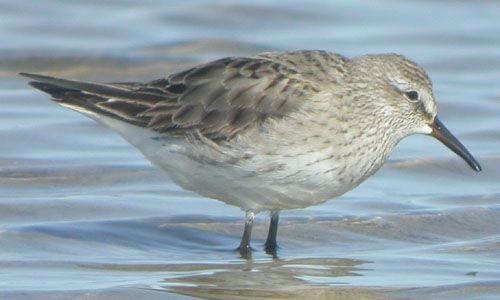 |
| White-rumped Sandpiper: Adult, Co. Wexford, September. In this close view the pale base to the lower mandible and decurved culmen are immediately obvious. Note the greyer upperparts, obvious supercilium and streaked flanks (photo: Paul and Andrea Kelly).
In summer plumage White-rumped is a greyish wader with an obvious narrow white supercilium. On the upperparts the scapulars can be quite rufous, though late-summer adults tend to be quite grey on the upperparts as they progress through to winter plumage. The underparts of adults are well streaked, with streaking extending onto flanks.
Juvenile/1st-winter birds have heavily whitish-fringed upperparts, with rufous scapulars, tertial edges and mantle. White tips to the scapulars create the typical white Vs associated with juvenile White-rumped. Baird's can exhibit similar markings, but not to the same extent. Like adults in winter plumage, juvenile Baird's exhibits an obvious supercilium, more so than that of the adult, and has a more evenly streaked breast band.
AcknowledgementsMany thanks to Martin Garner for useful comments in the preparation of this article. |

